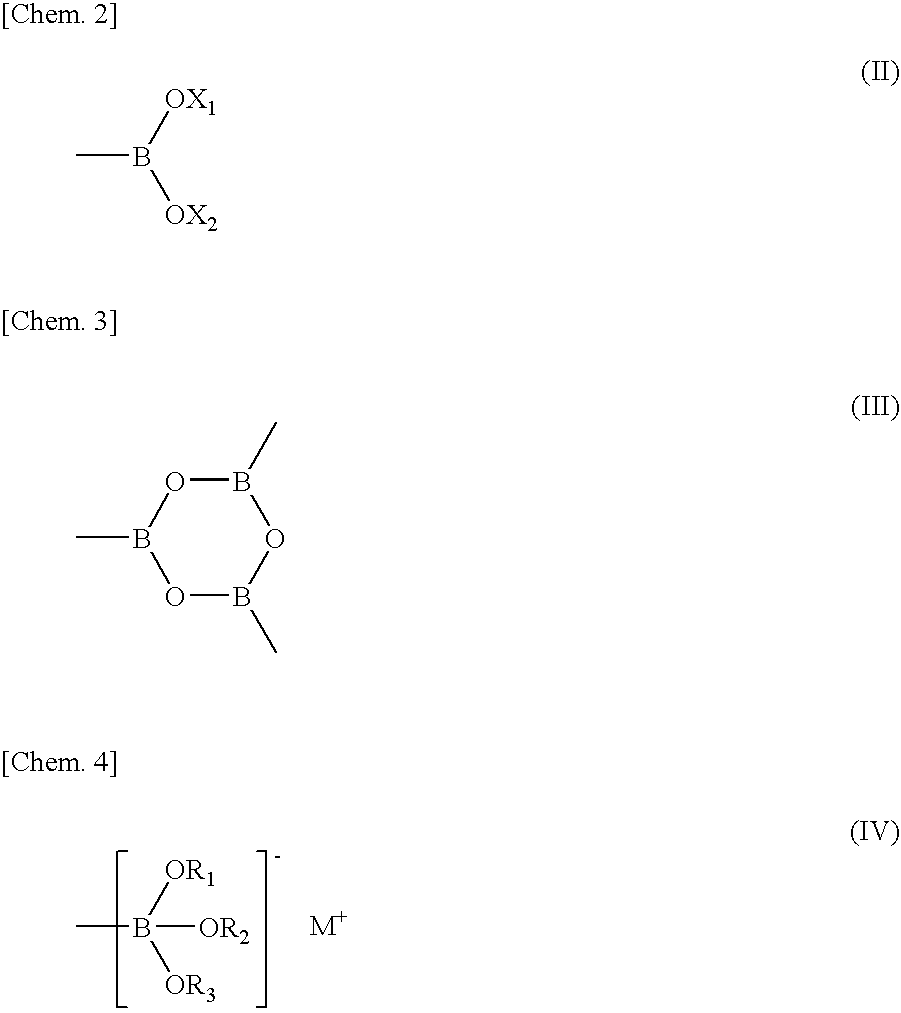Multi-Layer Structure and Process for Production Thereof
- Summary
- Abstract
- Description
- Claims
- Application Information
AI Technical Summary
Benefits of technology
Problems solved by technology
Method used
Image
Examples
synthesis example 1
Preparation of High Density Polyethylene Having an Ethylene Glycol Boronate Group at an End Thereof
[0093] In a separable flask equipped with a cooler, a stirrer and a dropping funnel, 1000 g of high density polyethylene {MFR=0.3 g / 10 min (at 190° C., under 2160 g load), density=0.952 g / cm3, amount of end double bonds=0.048 meq / g (mmol / g)} and 2500 g of decalin were added. After degassing by reducing pressure at room temperature, the atmosphere was replaced by nitrogen. To this system, 78 g of trimethyl borate and 5.8 g of borane-triethylamine complex were added. After a reaction was continued at 200° C. for 4 hours, a distillation instrument was attached and 100 ml of methanol was dropped slowly. After the completion of the methanol dropping, low-boiling impurities such as methanol, trimethyl borate and triethylamine were distilled off by distillation under reduced pressure. After further addition of 31 g of ethylene glycol, followed by stirring for 10 minutes, reprecipitation was ...
synthesis example 2
Preparation of Very Low Density Polyethylene Having an Ethylene Glycol Boronate Group at an End Thereof
[0094] In a separable flask equipped with a cooler, a stirrer and a dropping funnel, 1000 g of very low density polyethylene {MFR=15 g / 10 min (at 190° C., under 2160 g load), density=0.900 g / cm3, amount of end double bonds=0.055 meq / g (mmol / g)} and 2500 g of decalin were added. After degassing by reducing pressure at room temperature, the atmosphere was replaced by nitrogen. To this system, 78 g of trimethyl borate and 5.8 g of borane-triethylamine complex were added. After a reaction was continued at 200° C. for 4 hours, a distillation instrument was attached and 100 ml of methanol was dropped slowly. After the completion of the methanol dropping, low-boiling impurities such as methanol, trimethyl borate and triethylamine were distilled off by distillation under reduced pressure. After further addition of 31 g of ethylene glycol, followed by stirring for 10 minutes, reprecipitati...
referential example 1
[0095] To a twin screw type vented extruder, 1 part by weight of modified polyethylene (d-1: BEAG-modified HDPE) prepared in Synthesis Example 1, 5 parts by weight of EVOH made by Kuraray Co., Ltd. “EVAL®-F101” (ethylene content=32 mol %, degree of saponification=99.5%, intrinsic viscosity=1.1 dl / g), 8 parts by weight of maleic anhydride-modified polyethylene made by Mitsui Chemicals, Inc. “ADMER® GT6” {MFR=0.94 g / 10 min (at 190° C., under 2160 g load)}, and 86 parts by weight of high density polyethylene made by Bassel “Lupolen® 4261AG” (MFR=0.03 g / 10 min (at 190° C., under 2160 g load), density=0.945 g / cm3) were fed, followed by extrusion pelletization at 220° C. under a nitrogen atmosphere. Thus, pellets of a resin composition was obtained.
Evaluation of Film Appearance
[0096] Using the pellets obtained, a film was produced by use of a machine shown below and the appearance of the film was evaluated.
[0097] Machine used: twin screw extruder made by Toyo Seiki Seisaku-Sho, Ltd.
[...
PUM
| Property | Measurement | Unit |
|---|---|---|
| Fraction | aaaaa | aaaaa |
| Percent by mass | aaaaa | aaaaa |
| Percent by mass | aaaaa | aaaaa |
Abstract
Description
Claims
Application Information
 Login to View More
Login to View More - R&D
- Intellectual Property
- Life Sciences
- Materials
- Tech Scout
- Unparalleled Data Quality
- Higher Quality Content
- 60% Fewer Hallucinations
Browse by: Latest US Patents, China's latest patents, Technical Efficacy Thesaurus, Application Domain, Technology Topic, Popular Technical Reports.
© 2025 PatSnap. All rights reserved.Legal|Privacy policy|Modern Slavery Act Transparency Statement|Sitemap|About US| Contact US: help@patsnap.com


